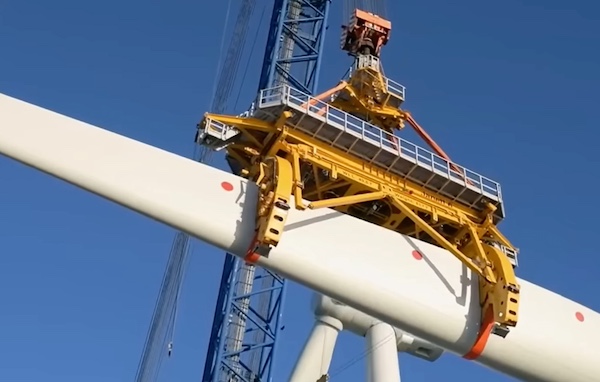
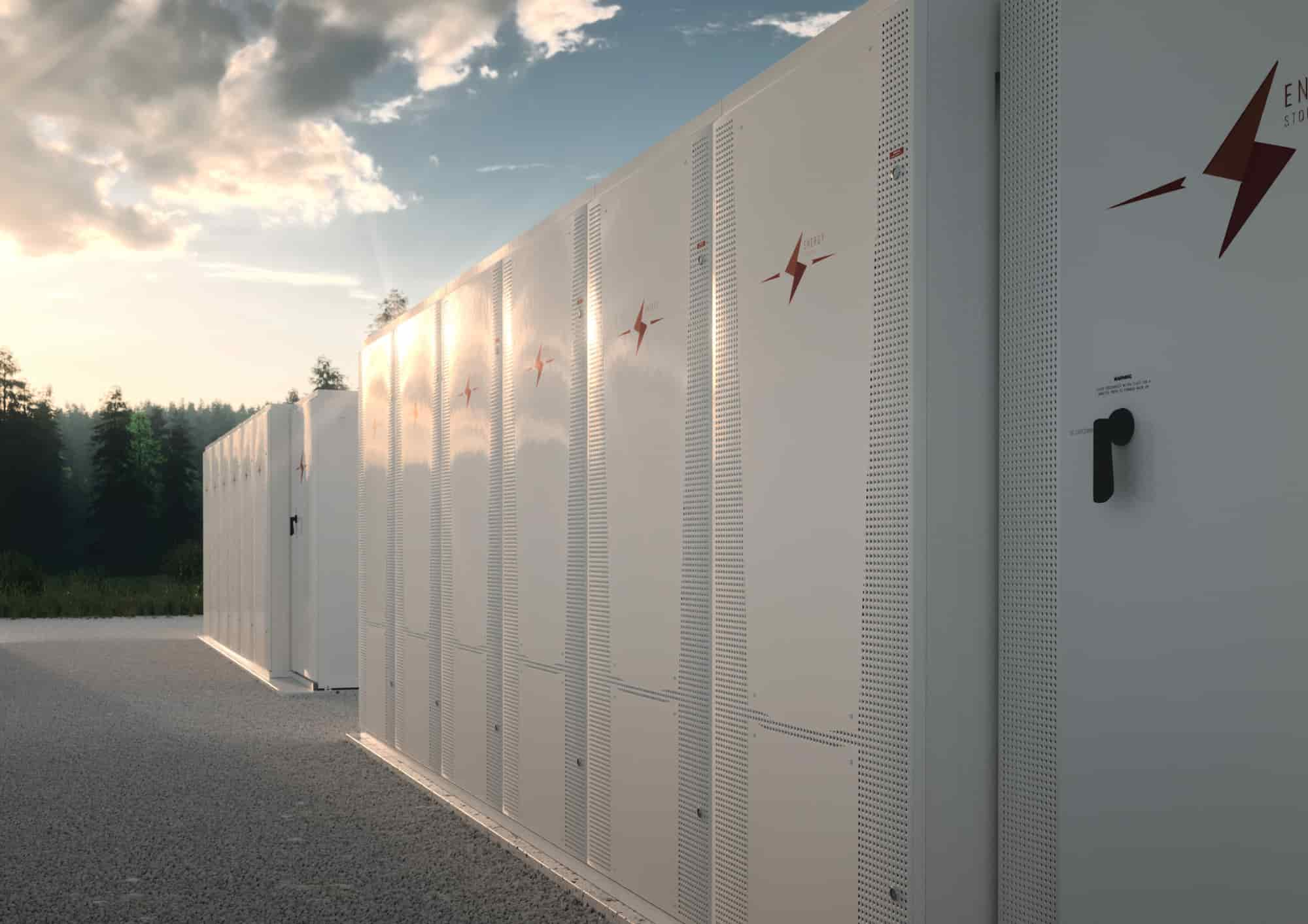
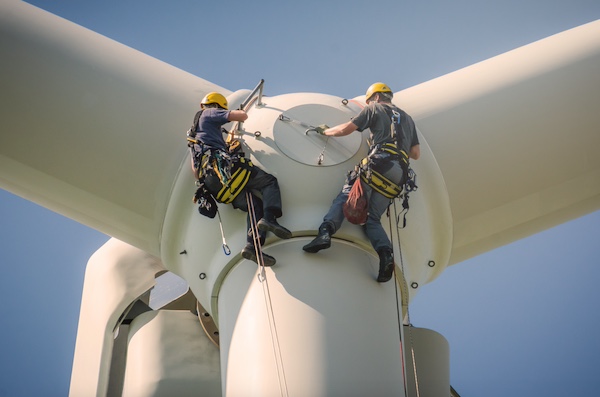
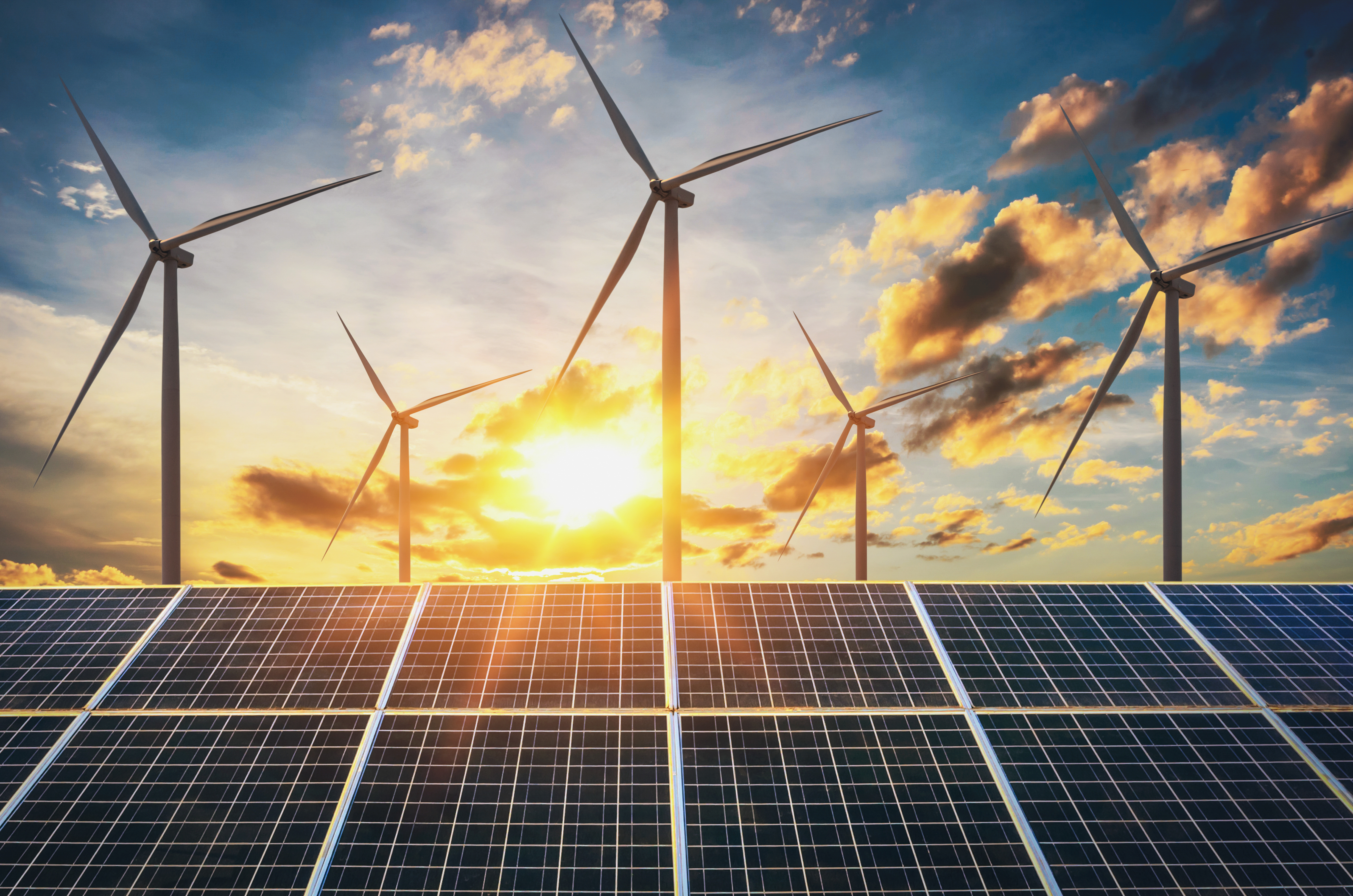
Aspen Power, a distributed generation platform with the mission of accelerating and democratizing decarbonization, announced that it has acquired eight ground-mounted solar projects in Pennsylvania and New York State from Solar Site Developers. These sites, totaling more than 41 megawatts of direct current (MWdc) projects.
The projects have been acquired by Aspen Power from Solar Site Developers who will co-develop them with Aspen Power. They are currentlyin the engineering design stage, with construction expected to begin in the coming months. The Pennsylvania projects will be net-metered under Pennsylvania’s Alternative Energy Portfolio Standard Act, while the NewYork projects will provide bill credits to utility customers via the Value of Distributed Energy Resources (VDER) program.
“We’re proud to advance decarbonization together with the team at Solar Site Developers, who have been committed partners in the preliminary stages of bringing these projects to life,” said Dan Gulick, Senior VicePresident, Community Solar, Aspen Power. “Building on Aspen Power’s portfolios in the Keystone state as well as our home state of New York is a key element of achieving our goal of gigawatt-scale in the coming years,” he added.
Aspen Power often works with early-stage developers to bring more clean, renewable energy online while providing a source of recurring revenues to landowners. Our development partners benefit from reliable project funding, streamlined implementation, and access to a broader pool of resources.
Meanwhile, hosting solar projects enables property owners to use their land or rooftops for renewable energy generation and receive regular payments. These types of projects also support the country’s renewable energy goals by increasing renewable energy production, promoting clean energy jobs and reducing greenhouse gas emissions.
Aspen Power | https://aspenpower.com/
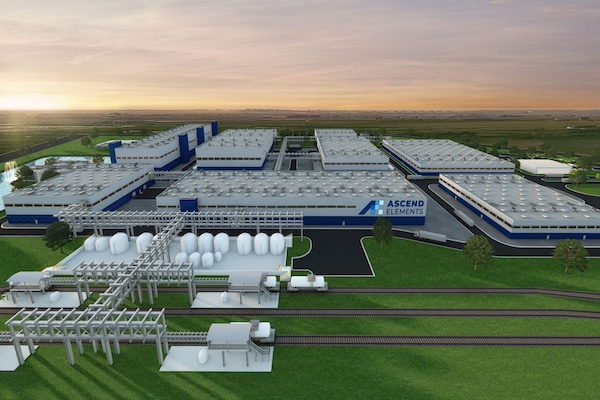
EV battery materials manufacturer Ascend Elements and the professional services firm Ernst & Young LLP (EY US) are collaborating on the road to net zero carbon emissions. Ascend Elements recently selected EY US to develop a complex logistics simulation model in preparation for the Q1 2025 startup of its 1 million-square-foot Apex 1 EV battery materials (pCAM) manufacturing facility in Hopkinsville, Kentucky. The Apex 1 campus will employ over 400 people and produce sustainable engineered battery materials for up to 750,000 electric vehicles per year.
“As you can imagine, a project of this size and scope requires a lot of logistics planning,” said Rodrigo Almeida, Sr. Director of Supply Chain at Ascend Elements. “EY US is using its experience and insight to help us anticipate logistical challenges and optimize our operations to achieve world-class efficiency and minimal impact on the community.”
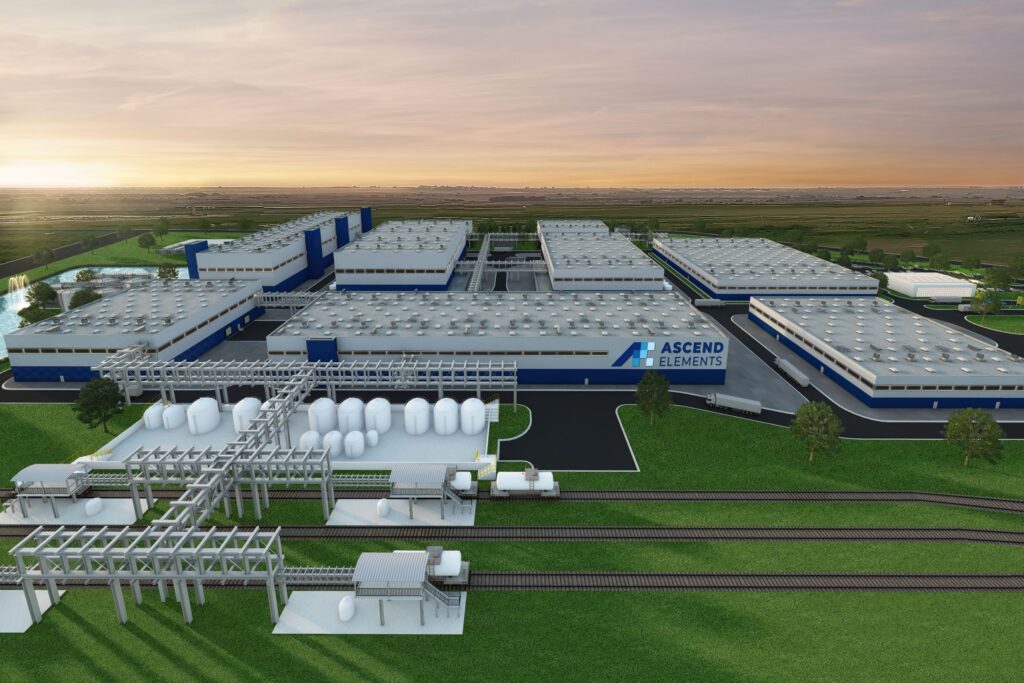
The facility will receive truckloads of recycled battery feedstock every day and ship over 450 metric tons of new, sustainable pCAM materials per week. The EY US logistics model can run simulations under many different scenarios to determine the most efficient way to operate the plant and manage traffic flow. “While the plant will bring new truck traffic to the area, we are actually creating a net reduction of carbon emissions by offsetting the need to ship newly mined battery materials from Asia,” Almeida said.
“Knowledge is power, especially for EV battery material manufacturing and recycling,” said Felipe Smolka, EY Americas Automotive eMobility Leader. “It’s been impactful working with Ascend Elements to predict possible logistical challenges and opportunities, as the transition planning will help inform manufacturing operations. At EY US, we believe the energy transition is a critical aspect of the automotive industry’s future and one that manufacturers must consider.”
“We had a lot of questions about traffic flow and timing that the simulation helped us understand,” said Bruno Feitosa, an industrial engineer at Ascend Elements. “How many trucks can the site accommodate at one time? Will trucks have room to queue up onsite without creating unnecessary traffic on local roads? How long will it take to load and unload each truck? Do we need to take deliveries 24 hours a day, or can we load and unload in the daytime only? Understanding the answers to these questions is essential to plan for optimal efficiency and safety.”
Ascend Elements’ Apex 1 facility in Hopkinsville, Kentucky, will be North America’s first sustainable cathode precursor (pCAM) manufacturing facility. CAM and pCAM are engineered materials made to precise microstructure specifications for use in electric vehicle batteries. While most of the world’s pCAM and CAM are made in China from primary (mined) metals, US-based Ascend Elements is commercializing an ultraefficient method to make sustainable pCAM and CAM from black mass, the traditional output of lithium-ion battery recycling facilities. The patented Hydro-to-Cathode® direct precursor synthesis process eliminates several intermediary steps in the traditional cathode manufacturing process and provides significant economic and carbon-reduction benefits.
Ascend Elements | https://ascendelements.com/
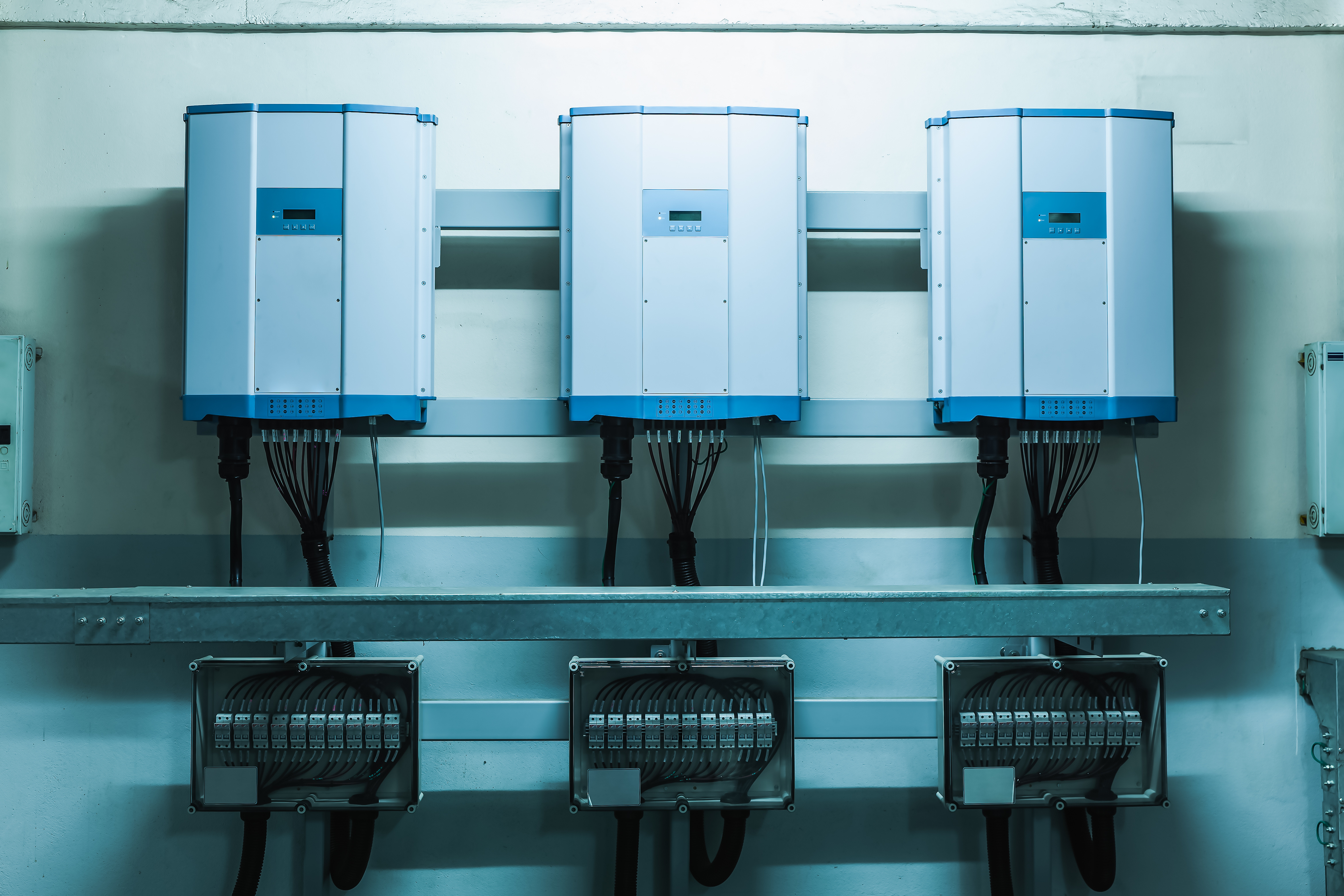
NeoVolta Inc., a San-Diego based leader in smart energy storage solutions, is thrilled to announce the appointment of Ardes Johnson as its new Chief Executive Officer. Mr. Johnson will officially assume his new role on April 29, 2024, bringing with him a wealth of experience and a proven track record of transformative leadership in the energy sector. His predecessor, Brent Willson, Founder and CEO of NeoVolta, will continue his role as Chairman of the Board and now serve as CTO.
“Ardes’ impressive track record in the energy sector, particularly his transformative role at Tesla, aligns perfectly with NeoVolta’s mission to innovate and lead in the renewable energy storage market,” said Brent Willson, outgoing CEO of NeoVolta. “We are confident that his visionary leadership and deep industry knowledge will continue to enhance our product offerings and expand market presence, ensuring reliable, safe, and efficient energy storage solutions for homes across America.”
“I am immensely excited to join NeoVolta at this pivotal moment and contribute to its mission with a focus on three key objectives: expanding revenue through strategic sales channel development, broadening financing options through partnerships with major industry players, and initiating the development of the next generation of NeoVolta batteries,” said incoming NeoVolta CEO Ardes Johnson. “Each of these areas is crucial for accelerating our growth and enhancing our competitive edge in the market. I have been eagerly awaiting the opportunity to apply my expertise to a product with as much potential as NeoVolta’s offerings, and I am confident that together, we will shape the future of energy storage.”
Johnson joins NeoVolta from Meyer Burger Americas, where, as President and General Manager, he spearheaded the company’s successful transition to module sales in the U.S. Under his leadership, Meyer Burger’s expansion in the Americas has achieved a multi-gigawatt backlog of over $1 billion dollars and is scaling to 2 gigawatts per year of manufacturing in just 18 months.
Prior to Meyer Burger, Johnson held various leadership roles in the energy space. However, his tenure at Tesla stands out as particularly noteworthy. As Director of Americas Sales and Marketing for Tesla’s Energy Products division, Johnson was instrumental in the development and success of Tesla’s energy storage solutions, where he and his team launched the partner channel program for the PowerWall and PowerPack products in the Utility, Residential and Commercial Markets. His leadership helped secure a landmark 80 MWh storage contract with Southern California Edison. This achievement was part of a broader strategy that significantly expanded Tesla's energy storage footprint across North America.
Johnson's background also includes strategic roles at SolarWorld Americas and General Electric, where he demonstrated his ability to drive profitability and innovation in highly competitive markets. His extensive experience is supported by a strong academic foundation, including a Master of Business Administration from Southern Methodist University, a Bachelor of Science in Mechanical Engineering from Texas Tech University and serving as a Naval Nuclear Officer aboard the USS Harry S Truman.
NeoVolta | www.neovolta.com

Standard Solar, a leading commercial and community solar developer and asset owner, along with CQI Associates, a leading renewable energy consulting and energy procurement company, have partnered with Unity Christian School in Decatur, Illinois, a ministry of the Lutheran School Association, to bring sustainable solar power to its campus located on Mound Road.
The project, developed and installed in collaboration with CQI Associates, Straight Up Solar and Lightwave Solar, marks a significant step towards reducing the school’s carbon footprint while enhancing its energy efficiency. Standard Solar is the project’s long-term owner and operator.
Yesterday, partners and community members gathered to celebrate the project’s completion and operation, marking a significant milestone in Unity Christian School’s journey toward sustainability.
“We are proud to partner with CQI and Unity Christian School in this endeavor to reduce the school’s carbon footprint and provide an educational platform for students to learn about renewable energy,” said Harry Benson, Director of Business Development, Standard Solar. “This collaboration directly aligns with our mission to promote sustainability and environmental stewardship.”
The 912 kilowatt, 2,028-panel ground-mount array covers three acres of the 54-acre campus, encompassing the space between the school’s football and baseball fields. The installation was carefully engineered and constructed so it does not impede the use of sports facilities or disrupt activities at the school.
“This project aligns well with our school values of innovation and collaboration,” said Brian Booth, Executive Leader, Unity Christian School. “We’re proud to be moving forward in a more efficient and sustainable way while also providing valuable hands-on learning experience for our students.”
“The project also offers an educational opportunity,” remarked Ed Keane, Facilities Manager at Unity Christian School. “Students can delve into solar power, experiencing its benefits firsthand and gaining insights into its workings.”
The project includes a real-time website allowing students to monitor the array’s energy production, fostering an interactive learning experience.
“We want to commend and congratulate the Unity Christian School, its Board and administration for having the foresight to employ solar energy and make this move towards a zero-carbon footprint,” said Richard Anderson, Chief Operating Officer, CQI Associates.
Standard Solar | standardsolar.com
CQI Associates | https://cqiassociates.com/
Unity Christian School | https://www.unitydecatur.org/
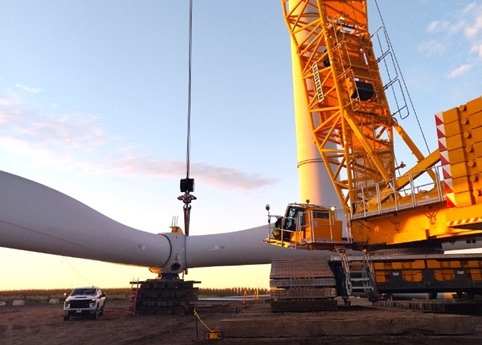
Greenbacker Renewable Energy Company LLC (“Greenbacker,” “GREC,” or the “Company”), a leading climate-focused investment manager and independent power producer, has secured $437 million in financing to repower two utility-scale wind energy assets in Iowa and complete a like-for-like equipment replacement at its largest wind farm in Minnesota (together, referred to as three “repowers”).
The repowers represent an energy transition milestone for Greenbacker. In addition to qualifying for the 30% investment tax credit (“ITC”), the projects are also among the clean energy industry’s first to utilize the additional 10% domestic content bonus newly created by the Inflation Reduction Act (“IRA”), based on their use of components manufactured in the US, including new turbine blades, hubs, and nacelles.
“These repowers are among the first deals to utilize the ‘domestic content adder’ put in place under the IRA—a win for US manufacturing—and we are quite frankly thrilled to be an early success story demonstrating that the legislation is bolstering additional renewables investment,” said Armand G. Dehaney, Principal of Investments at Greenbacker. “With the newly redeveloped projects, we are proud to create green jobs, generate tax revenue, and continue to produce affordable renewable power for Iowa and Minnesota. We’re grateful to the landowners for their support and we look forward to working closely with them for years to come.”
 The repowers also represent another milestone for Greenbacker: its first projects financed via sale-leaseback. The sale-leaseback structure provides Greenbacker greater upfront proceeds, while also creating a more efficient transaction that captures the benefits of both tax equity financing and back leverage lending in one transaction.
The repowers also represent another milestone for Greenbacker: its first projects financed via sale-leaseback. The sale-leaseback structure provides Greenbacker greater upfront proceeds, while also creating a more efficient transaction that captures the benefits of both tax equity financing and back leverage lending in one transaction.
Greenbacker repowers wind asset
Greenbacker has repowered its Hawkeye wind energy project (38 MW, IA), replacing older turbines with new, more efficient components that have been sourced domestically.
To finance the repowers, Greenbacker collaborated with existing lender Bayerische Landesbank (“BayernLB”) to secure $81.5 million in construction bridge loan facilities and additionally secured long-term debt and tax equity financing from Huntington National Bank via sale-leasebacks totaling $355.7 million.
“This marks our first tax credit transaction with Huntington, with whom we’ve closed our first sale-leaseback financing,” Dehaney said. “We look forward to executing on our pipeline of projects across our growing wind fleet with partners like BayernLB and Huntington, who share our vision for a sustainable world.”
Huntington, one of the largest US regional banks and a deeply experienced lender in sale-leaseback financing, was the sole provider of the long-term sale and leaseback tax equity financing for the three wind farms.
“Huntington is thrilled to have had the opportunity to provide a creative financing solution for this portfolio of wind assets,” said Zachary Shiffman, Vice President of Renewable Energy Finance at the bank. “We enjoyed collaborating with the Greenbacker team to create a long-term lease facility that was able to unlock the full benefits of the IRA’s domestic content adder and we look forward to working with them on additional projects in the near future.”
The transaction represents Greenbacker’s most recent clean energy collaboration with long-time financing partner BayernLB. In 2019, the companies partnered on the original financing for a portfolio of wind projects that included the three assets that GREC recently repowered.
“BayernLB is very pleased that, after leading the original debt financing of these assets for Greenbacker in 2019, we are able to provide this innovative repowering bridge financing that serves to improve the output and extend the life of these clean energy assets,” said Andrew Kjoller, Executive Director at BayernLB. “Such opportunities fit squarely within our stated strategy to support our clients in financing the energy transition.”
Bedrock Renewables LLC (“Bedrock”) led the development of the repowers and supported the financings, on behalf of Greenbacker. The Bedrock management team has extensive experience in renewable project development and finance, and was instrumental in resolving concerns from landowners, local administrations, and project partners to help ensure this repower portfolio was a success.
“Bedrock is grateful for the opportunity to support Greenbacker’s repowering initiatives,” said Justin Fike, Partner at Bedrock. “We have a long history with the Greenbacker team and look forward to continuing to partner with them on future repower projects.”
Work was completed at Greenbacker’s largest wind farm in Minnesota—the 30 MW Community Wind South project—and at the 42.5 MW Elk wind asset in Iowa in late 2023. The repower at GREC’s 37.5 MW Hawkeye wind project in Iowa finished in the first quarter of 2024.
Greenbacker Capital Management | https://greenbackercapital.com
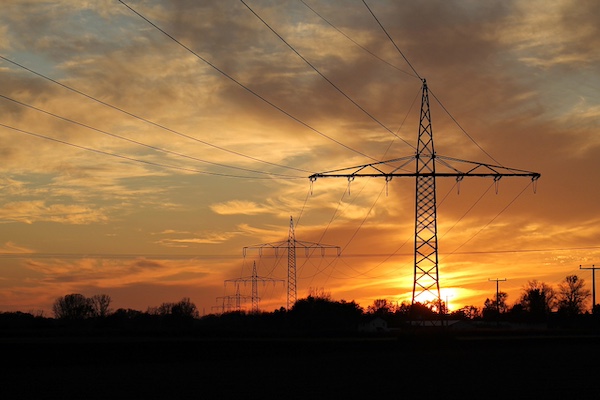
With approximately five billion tons of CO2 per year, the U.S. currently accounts for 13 percent of global CO2 emissions. Reducing these emissions will require a massive expansion of renewable energy. A key challenge for the U.S. energy transition is the grid integration of renewable generation capacities. There are already more than 1,200 gigawatts (GW) of solar and wind capacity that has yet to be connected to the power grid. By comparison, in 2023 China installed about 290 GW of solar and wind capacity, or about a quarter of the U.S. unconnected renewable energy capacity. In other words, the U.S. has four times as much unused capacity as China added last year. The German clean tech company envelio aims to unlock this potential by enabling grid operators and utilities to automate and dramatically accelerate the grid interconnection process. As a result, the German market leader in smart grid software is now expanding into the U.S.
Intelligent Grids for a sustainable future worldwide: envelio expands to the U.S.
The software specialist has been successfully offering its Intelligent Grid Platform (IGP) in Europe for some time. The IGP builds up and manages a digital twin of the power grid with a powerful network model management engine called Grid Hub. On this basis, the IGP provides a suite of integrated applications, several of which focus on accelerating the interconnection process. By automating grid data management and engineering analysis, the IGP enables a significant reduction of the processing time for grid interconnection requests and is able to handle the rapidly growing number of new requests over the next few years, without the need for long waiting times.
In Germany alone, envelio has already been able to automate the process of more than 55,000 interconnection requests by using the IGP in the last 12 months, which corresponds to a saving of more than 50,000 hours of work for engineers and technical planners. Next to interconnection solutions, the IGP also offers applications for data-driven decisions in other grid planning and grid operation processes. The European technology leader is now offering its award-winning software solution in the USA.
Dr. Simon Koopmann, Co-Founder and CEO of envelio, states: "The U.S. grids are facing a huge wave of interconnection requests creating an urgent need for efficient grid analysis, effective grid expansion, and creative grid integration concepts. For this reason, we are now launching our Intelligent Grid Platform in the U.S. We look forward to bringing our vision of intelligent grids worldwide in this compelling market and are excited by the challenges ahead."
One of the biggest challenges of the American energy transition is the digitization and, above all, the automation of the interconnection processes. By the end of 2023, there will be 1,086 GW of solar and 246 GW of wind (onshore) projects waiting to be connected to the grid. Dr. Koopmann adds: "These volumes illustrate the enormous untapped potential due to grid constraints. By automating the interconnection requests, we aim to unlock the potential for a rapid energy transition."
envelio wins internationally acclaimed BloombergNEF Award
Each year, BloombergNEF selects three innovative companies whose technologies help address three key challenges on the path to a net-zero economy. This year, envelio was honored in the category of 'Challenge 1: Relieving bottlenecks in the deployment of clean power.'
Claire Curry, selection committee co-chair and global head of Technology, Industry & Innovation research at BloombergNEF, stated: "BNEF set up the Pioneers award 14 years ago to recognize, and by doing so to accelerate, the progress of climate-tech innovators. The work of these decarbonization innovators is more important than ever in this critical decade: the search for new climate solutions has never been as urgent. Our winners this year span, among other things, technology breakthroughs in clean fuels, methods of advancing building decarbonization, and new routes to accelerate the deployment of renewables."
Dr. Koopmann concludes: "I am very proud of what the entire envelio team has achieved over the past few years. Winning the Bloomberg NEF Award not only demonstrates to us that we are on the right track, but also highlights the potential of our technology. It is also an excellent reference for our market entry in the USA."
About the Intelligent Grid Platform (IGP):
envelio's Intelligent Grid Platform (IGP) is a comprehensive software solution for the efficient planning and operational management of power distribution grids, providing a digital twin that processes, corrects and visualizes existing data. As smart metering increases the volume of data, the platform's accuracy improves, providing transparency into grid processes. The award-winning software adapts to different sizes of grid operators, making it a unique solution to the challenges of decentralized energy supply and distribution grid expansion. envelio's IGP enables grid operators to optimize and automate processes, laying the foundation for a rapid and decentralized global energy transition.
envelio | www.envelio.com

Bitech Technologies Corporation [OTCQB: BTTC], ("the Company" or "Bitech"), a technology solution provider dedicated to green energy solutions, is pleased to announce that it has completed the previously announced acquisition of Emergen Energy LLC ("Emergen") on April 24, 2024. Emergen was a wholly owned subsidiary of Texas-based Bridgelink Development, LLC ("Bridgelink"), a tier 1 solar and energy storage project development company, to control a pipeline of approximately 5.8 GW (gigawatts) of power in several battery energy storage system (BESS) and solar projects. This acquisition is expected to enable the Company to march toward sustainable growth.
"The acquisition of Emergen is expected to strengthen Bitech's position as new player in the green energy sector with projected sustainable operating assets", stated Benjamin Tran, Chairman and CEO of Bitech Technologies. "This partnership marks an exciting new chapter in our pursuit of sustainable and impactful solutions for a greener tomorrow while aiming to uplist to NASDAQ."
"We are thrilled to join forces with Bitech to advance our next phase of expansion together. Our mutual objective is to invest in and advance clean and adaptable renewable energy technologies, paving the way for a sustainable future," commented Cole Johnson, former CEO of Bridgelink Development and new Board Member and President of Bitech Technologies.
This historic milestone showcases our unwavering commitment to transparency, corporate governance, and value creation for our shareholders. It also serves as a testament to our preparedness for the next phase of expansion, as we strive towards sustainable operations and accelerated growth. We are confident that this strategic merger will not only enhance our position in the energy market but also deliver tangible benefits for all shareholders.
With this large asset play in business combination, our new management team believes Bitech is now positioned for significant growth with a pipeline of projects that, once funded and completed, have a potential valuation in the coming years of up to approximately $325 million in net present values (NPV) using discount cash flow (DCF) model based on our 2025 projected financials using industry standard multiples and discount rates. This strategic acquisition will not only strengthen Bitech's financial position, but also provide access to new technologies and global markets. As a result, Bitech is ready to begin planning for a NASDAQ uplisting, which will further enhance its credibility and visibility among investors, setting a solid foundation for Bitech's future success and expansion in the renewable energy industry.
With 1.965 GW of BESS power capacity in Emergen's project pipeline, we believe we have the ability to control almost 10% of the U.S. BESS market share assuming we obtain financing for all planned BESS projects and are able to develop them. According to Energy Storage News in November 2023, the BESS development pipeline in the U.S. has grown by 50% year-over-year to around 21.5 GW, comprised of 262 projects.[1] Thanks to the rapid expansion of the solar industry, the U.S. now has about 161 gigawatts of solar installed.[2] With 3.8GW of solar power in its pipeline, we believe we have the potential to secure about 2.5% of the U.S. solar market share assuming we obtain financing for all planned solar projects and are able to develop them.
This news closely follows behind the $7 billion in the U.S. federal solar power grants on Earth Day as solar is gaining traction as a key renewable energy source that could reduce the nation's reliance on fossil fuels, which emit planet-warming greenhouse gases.[3]
Comprehensive details of the transactions related to the acquisition of Emergen, as well as its audited financial statements, will be disclosed in the upcoming Form 8-Ks and other filings with the Securities and Exchange Commission.
1 See: US large-scale BESS installations in 2023 already exceed whole of 2022
2 See: The US installed more solar in 2023 than ever before
3 See: $7 Billion in federal solar power grants on Earth Day
Bitech Technologies Corporation | www.bitech.tech
Bridgelink Development | www.bridgelinkinvestments.com
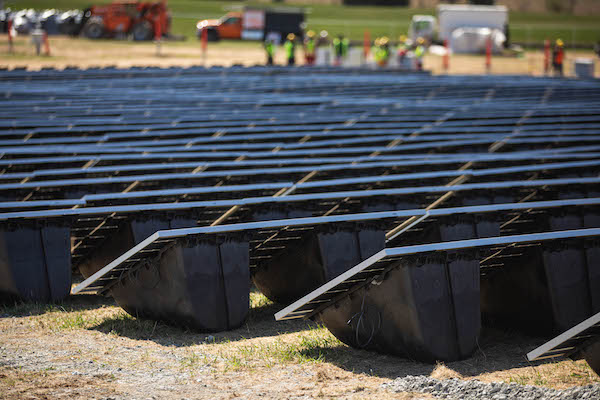
Alternative Energies May 15, 2023
The United States is slow to anger, but relentlessly seeks victory once it enters a struggle, throwing all its resources into the conflict. “When we go to war, we should have a purpose that our people understand and support,” as former Secretary ....

Unleashing trillions of dollars for a resilient energy future is within our grasp — if we can successfully navigate investment risk and project uncertainties.
The money is there — so where are the projects?
A cleaner and more secure energy future will depend on tapping trillions of dollars of capital. The need to mobilize money and markets to enable the energy transition was one of the key findings of one of the largest studies ever conducted among the global energy sector C-suite. This will mean finding ways to reduce the barriers and uncertainties that prevent money from flowing into the projects and technologies that will transform the energy system. It will also mean fostering greater collaboration and alignment among key players in the energy space.
 Interestingly, the study found that insufficient access to finance was not considered the primary cause of the current global energy crisis. In fact, capital was seen to be available — but not being unlocked. Why is that? The answer lies in the differing risk profiles of energy transition investments around the world. These risks manifest in multiple ways, including uncertainties relating to project planning, public education, stakeholder engagement, permitting, approvals, policy at national and local levels, funding and incentives, technology availability, and supply chains.
Interestingly, the study found that insufficient access to finance was not considered the primary cause of the current global energy crisis. In fact, capital was seen to be available — but not being unlocked. Why is that? The answer lies in the differing risk profiles of energy transition investments around the world. These risks manifest in multiple ways, including uncertainties relating to project planning, public education, stakeholder engagement, permitting, approvals, policy at national and local levels, funding and incentives, technology availability, and supply chains.
These risks need to be addressed to create more appealing investment opportunities for both public and private sector funders. This will require smart policy and regulatory frameworks that drive returns from long-term investment into energy infrastructure. It will also require investors to recognize that resilient energy infrastructure is more than an ESG play — it is a smart investment in the context of doing business in the 21st century.
Make de-risking investment profiles a number one priority
According to the study, 80 percent of respondents believe the lack of capital being deployed to accelerate the transition is the primary barrier to building the infrastructure required to improve energy security. At the same time, investors are looking for opportunities to invest in infrastructure that meets ESG and sustainability criteria. This suggests an imbalance between the supply and demand of capital for energy transition projects.
How can we close the gap?
One way is to link investors directly to energy companies. Not only would this enable true collaboration and non-traditional partnerships, but it would change the way project financing is conceived and structured — ultimately aiding in potentially satisfying the risk appetite of latent but hugely influential investors, such as pension funds. The current mismatch of investor appetite and investable projects reveals a need for improving risk profiles, as well as a mindset shift towards how we bring investment and developer stakeholders together for mutual benefit. The circular dilemma remains: one sector is looking for capital to undertake projects within their skill to deploy, while another sector wonders where the investable projects are.
This conflict is being played out around the world; promising project announcements are made, only to be followed by slow progress (or no action at all). This inertia results when risks are compounded and poorly understood. To encourage collaboration between project developers and investors with an ESG focus, more attractive investment opportunities can be created by pulling several levers: public and private investment strategies, green bonds and other sustainable finance instruments, and innovative financing models such as impact investing.

Expedite permitting to speed the adoption of new technologies
Another effective strategy to de-risk investment profiles is found in leveraging new technologies and approaches that reduce costs, increase efficiency, and enhance the reliability of energy supply. Research shows that 62 percent of respondents indicated a moderate or significant increase in investment in new and transitional technologies respectively, highlighting the growing interest in innovative solutions to drive the energy transition forward.
Hydrogen, carbon capture and storage, large-scale energy storage, and smart grids are some of the emerging technologies identified by survey respondents as having the greatest potential to transform the energy system and create new investment opportunities. However, these technologies face challenges such as long lag times between conception and implementation.
If the regulatory environment makes sense, then policy uncertainty is reduced, and the all-important permitting pathways are well understood and can be navigated. Currently, the lack of clear, timely, and fit-for-purpose permitting is a major roadblock to the energy transition. To truly unleash the potential of transitional technologies requires the acceleration of regulatory systems that better respond to the nuance and complexity of such technologies (rather than the current one-size-fits all approach). In addition, permitting processes must also be expedited to dramatically decrease the period between innovation, commercialization, and implementation. One of the key elements of faster permitting is effective consultation with stakeholders and engagement with communities where these projects will be housed for decades. This is a highly complex area that requires both technical and communication skills.
The power of collaboration, consistency, and systems thinking
The report also reveals the need for greater collaboration among companies in the energy space to build a more resilient system. The report shows that, in achieving net zero, there is a near-equal split between those increasing investment (47 percent of respondents), and those decreasing investment (39 percent of respondents). This illustrates the complexity and diversity of the system around the world. A more resilient system will require all its components – goals and actions – to be aligned towards a common outcome.
Another way to de-risk the energy transition is to establish consistent, transparent, and supportive policy frameworks that encourage investment and drive technological innovation. The energy transition depends on policy to guide its direction and speed by affecting how investors feel and how the markets behave. However, inconsistent or inadequate policy can also be a source of uncertainty and instability. For example, shifting political priorities, conflicting international standards, and the lack of market-based mechanisms can hinder the deployment of sustainable technologies, resulting in a reluctance to commit resources to long-term projects.
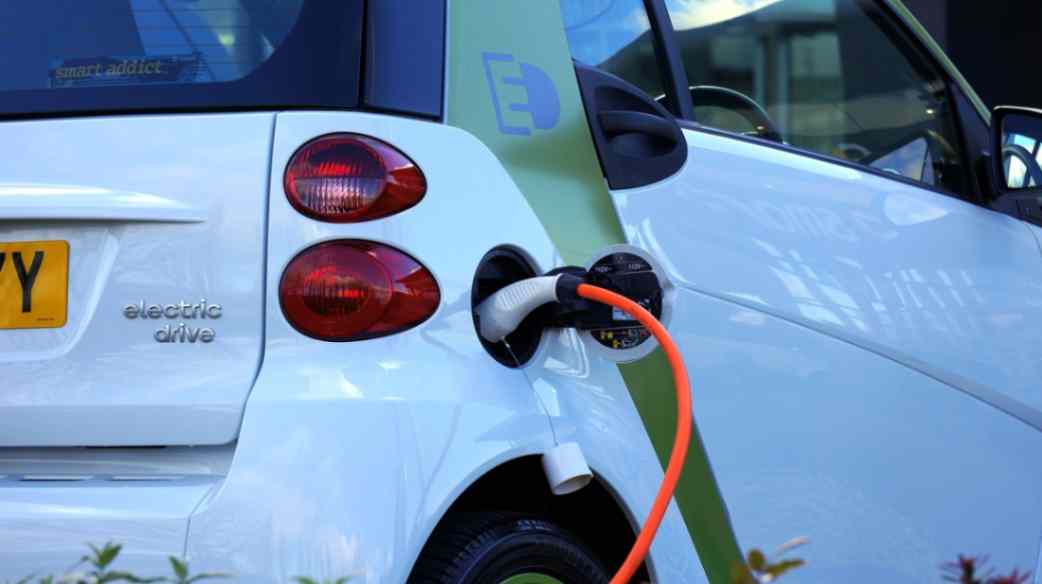
Variations in country-to-country deployment creates disparities in energy transition progress. For instance, the 2022 Inflation Reduction Act in the US has posed challenges for the rest of the world, by potentially channeling energy transition investment away from other markets and into the US. This highlights the need for a globally unified approach to energy policy that balances various national interests while addressing a global problem.
To facilitate the energy transition, it is imperative to establish stable, cohesive, and forward-looking policies that align with global goals and standards. By harmonizing international standards, and providing clear and consistent signals, governments and policymakers can generate investor confidence, helping to foster a robust energy ecosystem that propels the sector forward.
Furthermore, substantive and far-reaching discussions at international events like the United Nations Conference of the Parties (COP), are essential to facilitate this global alignment. These events provide an opportunity to de-risk the energy transition through consistent policy that enables countries to work together, ensuring that the global community can tackle the challenges and opportunities of the energy transition as a united front.
Keeping net-zero ambitions on track
Despite the challenges faced by the energy sector, the latest research reveals a key positive: 91 percent of energy leaders surveyed are working towards achieving net zero. This demonstrates a strong commitment to the transition and clear recognition of its importance. It also emphasizes the need to accelerate our efforts, streamline processes, and reduce barriers to realizing net-zero ambitions — and further underscores the need to de-risk energy transition investment by removing uncertainties.
The solution is collaborating and harmonizing our goals with the main players in the energy sector across the private and public sectors, while establishing consistent, transparent, and supportive policy frameworks that encourage investment and drive technological innovation.
These tasks, while daunting, are achievable. They require vision, leadership, and action from all stakeholders involved. By adopting a new mindset about how we participate in the energy system and what our obligations are, we can stimulate the rapid progress needed on the road to net zero.
Dr. Tej Gidda (Ph.D., M.Sc., BSc Eng) is an educator and engineer with over 20 years of experience in the energy and environmental fields. As GHD Global Leader – Future Energy, Tej is passionate about moving society along the path towards a future of secure, reliable, and affordable low-carbon energy. His focus is on helping public and private sector clients set and deliver on decarbonization goals in order to achieve long-lasting positive change for customers, communities, and the climate. Tej enjoys fostering the next generation of clean energy champions as an Adjunct Professor at the University of Waterloo Department of Civil and Environmental Engineering.
GHD | www.ghd.com
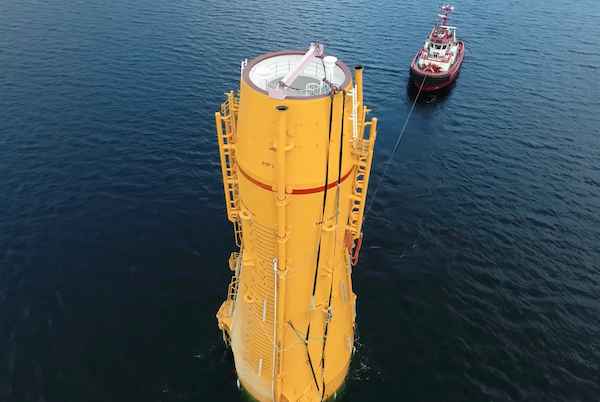
The Kincardine floating wind farm, located off the east coast of Scotland, was a landmark development: the first commercial-scale project of its kind in the UK sector. Therefore, it has been closely watched by the industry throughout its installation. With two of the turbines now having gone through heavy maintenance, it has also provided valuable lessons into the O&M processes of floating wind projects.
In late May, the second floating wind turbine from the five-turbine development arrived in the port of Massvlakte, Rotterdam, for maintenance. An Anchor Handling Tug Supply (AHTS)
vessel was used to deliver the KIN-02 turbine two weeks after a Platform Supply Vessel (PSV) and AHTS had worked to disconnect the turbine from the wind farm site. The towing vessel became the third vessel used in the operation.
This is not the first turbine disconnected from the site and towed for maintenance. In the summer of 2022, KIN-03 became the world’s first-ever floating wind turbine that required heavy maintenance (i.e. being disconnected and towed for repair). It was also towed from Scotland to Massvlakte.
Each of these operations has provided valuable lessons for the ever-watchful industry in how to navigate the complexities of heavy maintenance in floating wind as the market segment grows.

The heavy maintenance process
When one of Kincardine’s five floating 9.5 MW turbines (KIN-03) suffered a technical failure in May 2022, a major technical component needed to be replaced. The heavy maintenance strategy selected by the developer and the offshore contractors consisted in disconnecting and towing the turbine and its floater to Rotterdam for maintenance, followed by a return tow and re-connection. All of the infrastructure, such as crane and tower access, remained at the quay following the construction phase. (Note, the following analysis only covers KIN-03, as details of the second turbine operation are not yet available).
Comparing the net vessel days for both the maintenance and the installation campaigns at this project highlights how using a dedicated marine spread can positively impact operations.
For this first-ever operation, a total of 17.2 net vessel days were required during turbine reconnection—only a slight increase on the 14.6 net vessel days that were required for the first hook-up operation performed during the initial installation in 2021. However, it exceeds the average of eight net vessel days during installation. The marine spread used in the heavy maintenance operation differed from that used during installation. Due to this, it did not benefit from the learning curve and experience gained throughout the initial installation, which ultimately led to the lower average vessel days.
The array cable re-connection operation encountered a similar effect. The process was performed by one AHTS that spent 10 net vessel days on the operation. This compares to the installation campaign, where the array cable second-end pull-in lasted a maximum of 23.7 hours using a cable layer.
Overall, the turbine shutdown duration can be broken up as 14 days at the quay for maintenance, 52 days from turbine disconnection to turbine reconnection, and 94 days from disconnection to the end of post-reconnection activities.
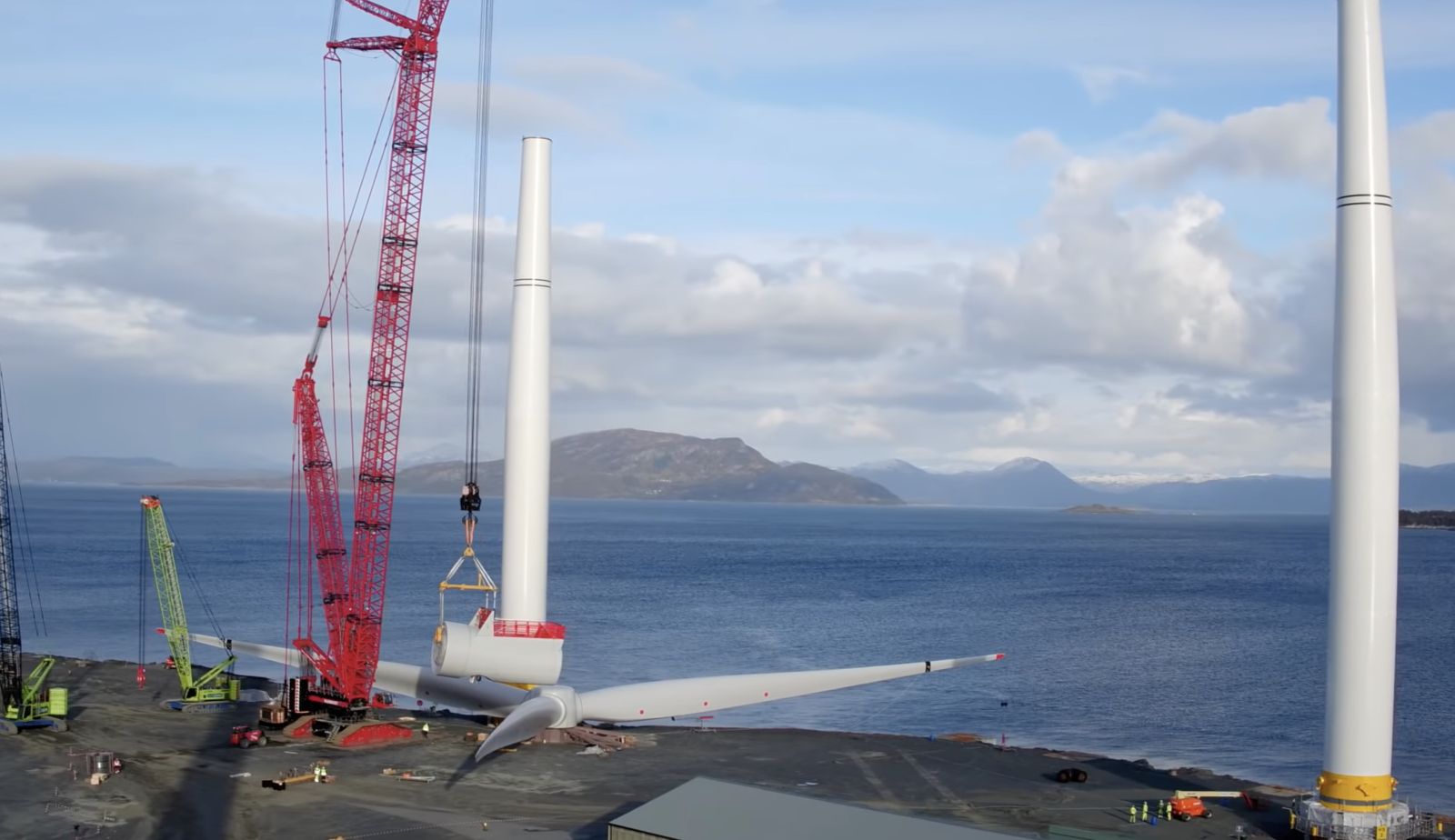
What developers should keep in mind for heavy maintenance operations
This analysis has uncovered two main lessons developers should consider when planning a floating wind project: the need to identify an appropriate O&M port, and to guarantee that a secure fleet is available.
Floating wind O&M operations require a port with both sufficient room and a deep-water quay. The port must also be equipped with a heavy crane with sufficient tip height to accommodate large floaters and reach turbine elevation. Distance to the wind farm should also be taken into account, as shorter distances will reduce towing time and, therefore, minimize transit and non-productive turbine time.
During the heavy maintenance period for KIN-03 and KIN-02, the selected quay (which had also been utilized in the initial installation phase of the wind farm project), was already busy as a marshalling area for other North Sea projects. This complicated the schedule significantly, as the availability of the quay and its facilities had to be navigated alongside these other projects. This highlights the importance of abundant quay availability both for installation (long-term planning) and maintenance that may be needed on short notice.
At the time of the first turbine’s maintenance program (June 2022), the North Sea AHTS market was in an exceptional situation: the largest bollard pull AHTS units contracted at over $200,000 a day, the highest rate in over a decade.
During this time, the spot market was close to selling out due to medium-term commitments, alongside the demand for high bollard pull vessels for the installation phase at a Norwegian floating wind farm project. The Norwegian project required the use of four AHTS above a 200t bollard pull. With spot rates ranging from $63,000 to $210,000 for the vessels contracted for Kincardine’s maintenance, the total cost of the marine spread used in the first repair campaign was more than $4 million.
Developers should therefore consider the need to structure maintenance contracts with AHTS companies, either through frame agreements or long-term charters, to decrease their exposure to spot market day rates as the market tightens in the future.

While these lessons are relevant for floating wind developers now, new players are looking towards alternative heavy O&M maintenance options for the future. Two crane concepts are especially relevant in this instance. The first method is for a crane to be included in the turbine nacelle to be able to directly lift the component which requires repair from the floater, as is currently seen on onshore turbines. This method is already employed in onshore turbines and could be applicable for offshore. The second method is self-elevating cranes with several such solutions already in development.
The heavy maintenance operations conducted on floating turbines at the Kincardine wind farm have provided invaluable insights for industry players, especially developers. The complex process of disconnecting and towing turbines for repairs highlights the need for meticulous planning and exploration of alternative maintenance strategies, some of which are already in the pipeline. As the industry evolves, careful consideration of ports, and securing fleet contracts, will be crucial in driving efficient and cost-effective O&M practices for the floating wind market.
Sarah McLean is Market Research Analyst at Spinergie, a maritime technology company specializing in emission, vessel performance, and operation optimization.
Spinergie | www.spinergie.com

According to the Energy Information Administration (EIA), developers plan to add 54.5 gigawatts (GW) of new utility-scale electric generating capacity to the U.S. power grid in 2023. More than half of this capacity will be solar. Wind power and battery storage are expected to account for roughly 11 percent and 17 percent, respectively.
A large percentage of new installations are being developed in areas that are prone to extreme weather events and natural disasters (e.g., Texas and California), including high wind, tornadoes, hail, flooding, earthquakes, wildfires, etc. With the frequency and severity of many of these events increasing, project developers, asset owners, and tax equity partners are under growing pressure to better understand and mitigate risk.
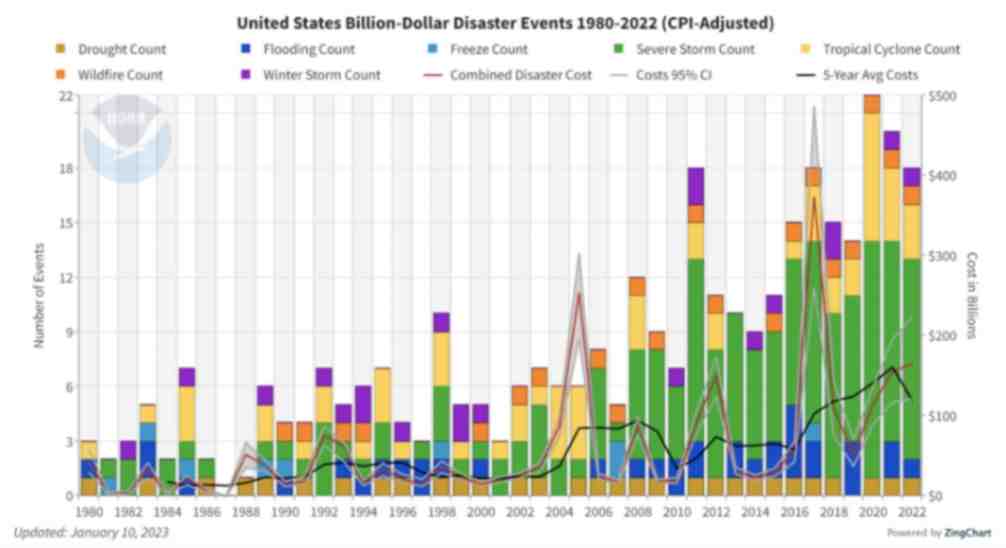
Figure 1. The history of billion-dollar disasters in the United States each year from 1980 to 2022 (source: NOAA)
In terms of loss prevention, a Catastrophe (CAT) Modeling Study is the first step to understanding the exposure and potential financial loss from natural hazards or extreme weather events. CAT studies form the foundation for wider risk management strategies, and have significant implications for insurance costs and coverage.
Despite their importance, developers often view these studies as little more than a formality required for project financing. As a result, they are often conducted late in the development cycle, typically after a site has been selected. However, a strong case can be made for engaging early with an independent third party to perform a more rigorous site-specific technical assessment. Doing so can provide several advantages over traditional assessments conducted by insurance brokerage affiliates, who may not possess the specialty expertise or technical understanding needed to properly apply models or interpret the results they generate. One notable advantage of early-stage catastrophe studies is to help ensure that the range of insurance costs, which can vary from year to year with market forces, are adequately incorporated into the project financial projections.
The evolving threat of natural disasters
Over the past decade, the financial impact of natural hazard events globally has been almost three trillion dollars. In the U.S. alone, the 10-year average annual cost of natural disaster events exceeding $1 billion increased more than fourfold between the 1980s ($18.4 billion) and the 2010s ($84.5 billion).

Investors, insurers, and financiers of renewable projects have taken notice of this trend, and are subsequently adapting their behavior and standards accordingly. In the solar market, for example, insurance premiums increased roughly four-fold from 2019 to 2021. The impetus for this increase can largely be traced back to a severe storm in Texas in 2019, which resulted in an $80 million loss on 13,000 solar panels that were damaged by hail.
The event awakened the industry to the hazards severe storms present, particularly when it comes to large-scale solar arrays. Since then, the impact of convective weather on existing and planned installations has been more thoroughly evaluated during the underwriting process. However, far less attention has been given to the potential for other natural disasters; events like floods and earthquakes have not yet resulted in large losses and/or claims on renewable projects (including wind farms). The extraordinary and widespread effect of the recent Canadian wildfires may alter this behavior moving forward.
A thorough assessment, starting with a CAT study, is key to quantifying the probability of their occurrence — and estimating potential losses — so that appropriate measures can be taken to mitigate risk.
All models are not created equal
Industrywide, certain misconceptions persist around the use of CAT models to estimate losses from an extreme weather event or natural disaster.
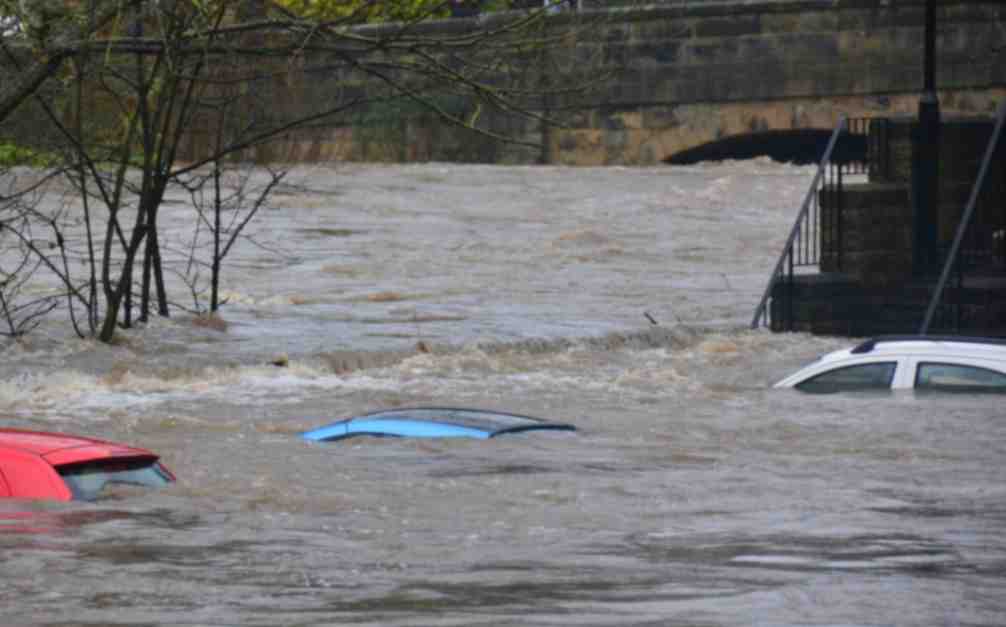
Often, the perception is that risk assessors only need a handful of model inputs to arrive at an accurate figure, with the geographic location being the most important variable. While it’s true that many practitioners running models will pre-specify certain project characteristics regardless of the asset’s design (for example, the use of steel moment frames without trackers for all solar arrays in a given region or state), failure to account for even minor details can lead to loss estimates that are off by multiple orders of magnitude.
The evaluation process has recently become even more complex with the addition of battery energy storage. Relative to standalone solar and wind farms, very little real-world experience and data on the impact of extreme weather events has been accrued on these large-scale storage installations. Such projects require an even greater level of granularity to help ensure that all risks are identified and addressed.
Even when the most advanced modeling software tools are used (which allow for thousands of lines of inputs), there is still a great deal that is subject to interpretation. If the practitioner does not possess the expertise or technical ability needed to understand the model, the margin for error can increase substantially. Ultimately, this can lead to overpaying for insurance. Worse, you may end up with a policy with insufficient coverage. In both cases, the profitability of the asset is impacted.
Supplementing CAT studies
In certain instances, it may be necessary to supplement CAT models with an even more detailed analysis of the individual property, equipment, policies, and procedures. In this way, an unbundled risk assessment can be developed that is tailored to the project. Supplemental information (site-specific wind speed studies and hydrological studies, structural assessment, flood maps, etc.) can be considered to adjust vulnerability models.
This provides an added layer of assurance that goes beyond the pre-defined asset descriptions in the software used by traditional studies or assessments. By leveraging expert elicitations, onsite investigations, and rigorous engineering-based methods, it is possible to discretely evaluate asset-specific components as part of the typical financial loss estimate study: this includes Normal Expected Loss (NEL), also known as Scenario Expected Loss (SEL); Probable Maximum Loss (PML), also known as Scenario Upper Loss (SUL); and Probabilistic Loss (PL).
Understanding the specific vulnerabilities and consequences can afford project stakeholders unique insights into quantifying and prioritizing risks, as well as identifying proper mitigation recommendations.
Every project is unique
The increasing frequency and severity of natural disasters and extreme weather events globally is placing an added burden on the renewable industry, especially when it comes to project risk assessment and mitigation. Insurers have signaled that insurance may no longer be the main basis for transferring risk; traditional risk management, as well as site and technology selection, must be considered by developers, purchasers, and financiers.
As one of the first steps in understanding exposure and the potential capital loss from a given event, CAT studies are becoming an increasingly important piece of the risk management puzzle. Developers should treat them as such by engaging early in the project lifecycle with an independent third-party practitioner with the specialty knowledge, tools, and expertise to properly interpret models and quantify risk.
Hazards and potential losses can vary significantly depending on the project design and the specific location. Every asset should be evaluated rigorously and thoroughly to minimize the margin for error, and maximize profitability over its life.
 Chris LeBoeuf is Global Head of the Extreme Loads and Structural Risk division of ABS Group, based in San Antonio, Texas. He leads a team of more than 60 engineers and scientists in the US, UK, and Singapore, specializing in management of risks to structures and equipment related to extreme loading events, including wind, flood, seismic and blast. Chris has more than 20 years of professional experience as an engineering consultant, and is a recognized expert in the study of blast effects and blast analysis, as well as design of buildings. He holds a Bachelor of Science in Civil Engineering from The University of Texas at San Antonio, and is a registered Professional Engineer in 12 states.
Chris LeBoeuf is Global Head of the Extreme Loads and Structural Risk division of ABS Group, based in San Antonio, Texas. He leads a team of more than 60 engineers and scientists in the US, UK, and Singapore, specializing in management of risks to structures and equipment related to extreme loading events, including wind, flood, seismic and blast. Chris has more than 20 years of professional experience as an engineering consultant, and is a recognized expert in the study of blast effects and blast analysis, as well as design of buildings. He holds a Bachelor of Science in Civil Engineering from The University of Texas at San Antonio, and is a registered Professional Engineer in 12 states.
ABS Group | www.abs-group.com
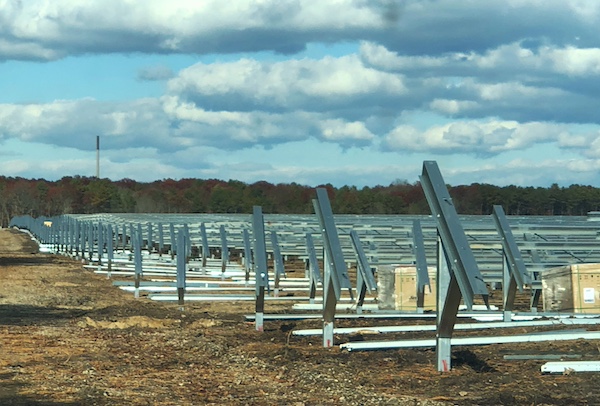
Throughout my life and career as a real estate developer in New York City, I’ve had many successes. In what is clearly one of my most unusual development projects in a long career filled with them, I initiated the building of a solar farm to help t....
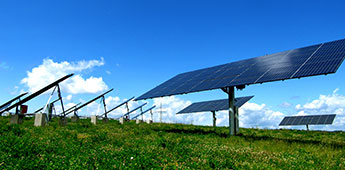
I’m just going to say it, BIPV is dumb. Hear me out…. Solar is the most affordable form of energy that has ever existed on the planet, but only because the industry has been working towards it for the past 15 years. Governments,....
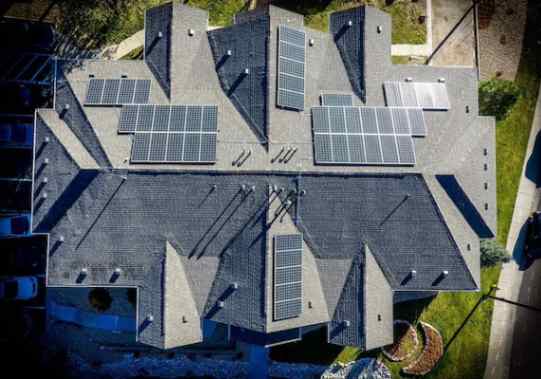
Heat waves encircled much of the earth last year, pushing temperatures to their highest in recorded history. The water around Florida was “hot-tub hot” — topping 101° and bleaching and killing coral in waters around the peninsula. Phoenix had ....
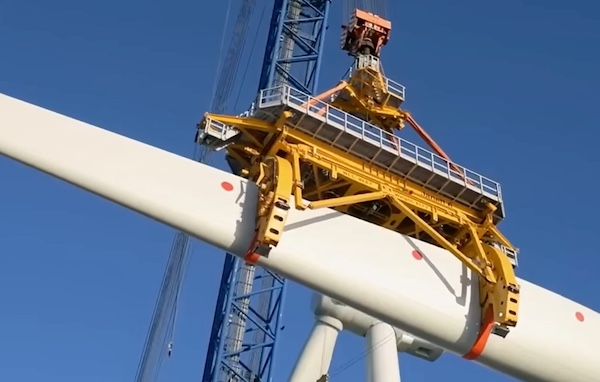
Wind turbines play a pivotal role in the global transition to sustainable energy sources. However, the harsh environmental conditions in which wind turbines operate, such as extreme temperatures, high humidity, and exposure to various contaminants, p....
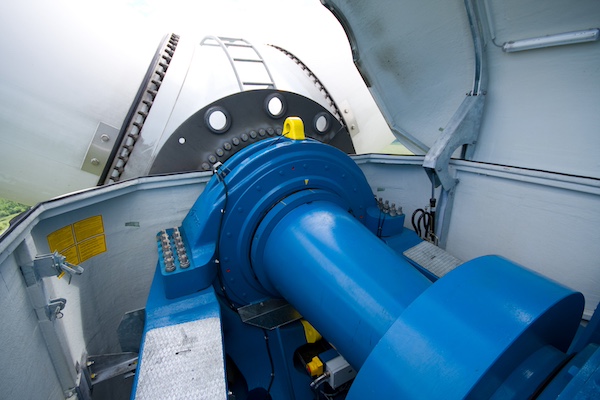
Wind energy remains the leading non-hydro renewable technology, and one of the fastest-growing of all power generation technologies. The key to making wind even more competitive is maximizing energy production and efficiently maintaining the assets. ....
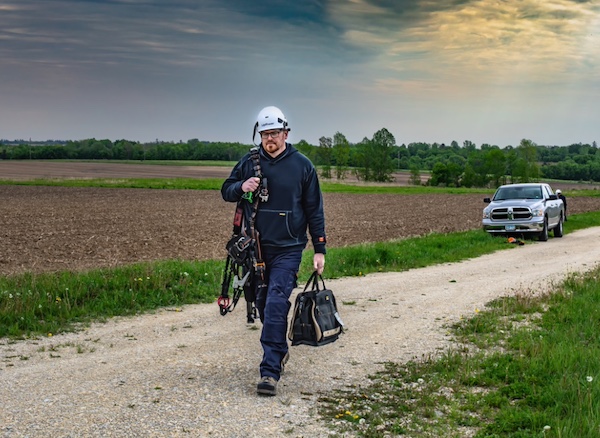
The allure of wind turbines is undeniable. For those fortunate enough to visit these engineering marvels, it’s an experience filled with awe and learning. However, the magnificence of these structures comes with inherent risks, making safety an abs....
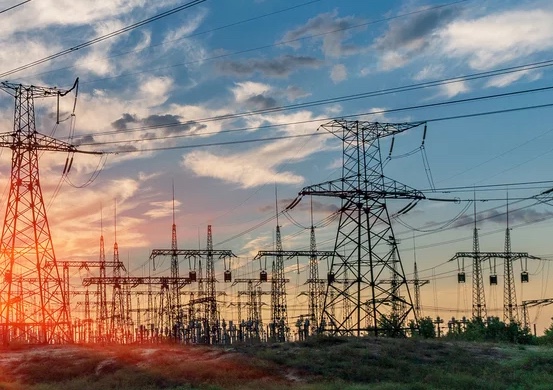
Battery energy storage is a critical technology to reducing our dependence on fossil fuels and build a low carbon future. Renewable energy generation is fundamentally different from traditional fossil fuel energy generation in that energy cannot be p....
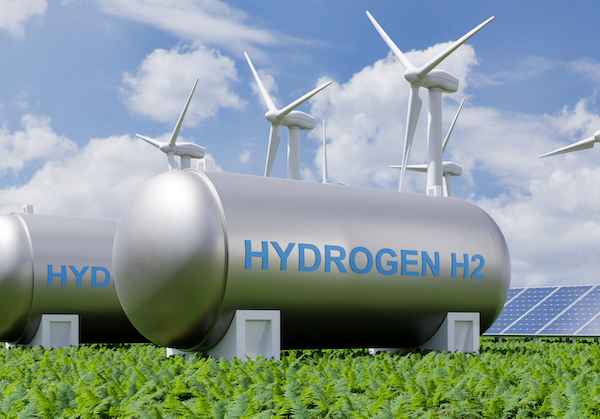
Not enough people know that hydrogen fuel cells are a zero-emission energy technology. Even fewer know water vapor's outsized role in electrochemical processes and reactions. Producing electricity through a clean electrochemical process with water....

In the ever-evolving landscape of sustainable transportation, a ground-breaking shift is here: 2024 ushers in a revolutionary change in Electric Vehicle (EV) tax credits in the United States. Under the Inflation Reduction Act (IRA), a transforma....

Now more than ever, it would be difficult to overstate the importance of the renewable energy industry. Indeed, it seems that few other industries depend as heavily on constant and rapid innovation. This industry, however, is somewhat unique in its e....

University of Toronto’s latest student residence welcomes the future of living with spaces that are warmed by laptops and shower water. In September 2023, one of North America’s largest residential passive homes, Harmony Commons, located....
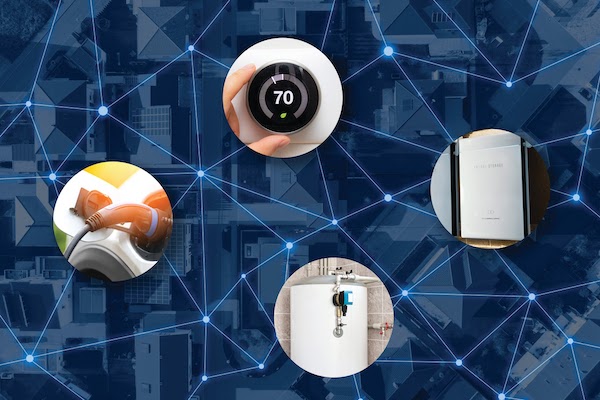
For decades, demand response (DR) has proven a tried-and-true conservation tactic to mitigate energy usage during peak demand hours. Historically, those peak demand hours were relatively predictable, with increases in demand paralleling commuter and ....